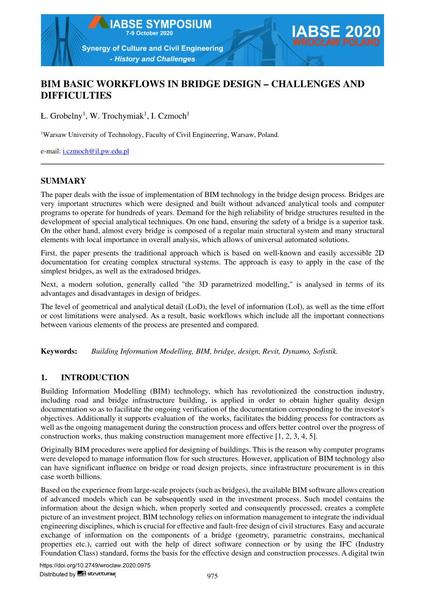BIM Basic Workflows in Bridge Design – Challenges and Difficulties

|
|
|||||||||||
Bibliographic Details
| Author(s): |
Ł. Grobelny
W. Trochymiak I. Czmoch |
||||
|---|---|---|---|---|---|
| Medium: | conference paper | ||||
| Language(s): | English | ||||
| Conference: | IABSE Symposium: Synergy of Culture and Civil Engineering – History and Challenges, Wrocław, Poland, 7-9 October 2020 | ||||
| Published in: | IABSE Symposium Wroclaw 2020 | ||||
|
|||||
| Page(s): | 975-982 | ||||
| Total no. of pages: | 8 | ||||
| Year: | 2020 | ||||
| DOI: | 10.2749/wroclaw.2020.0975 | ||||
| Abstract: |
The paper deals with the issue of implementation of BIM technology in the bridge design process. Bridges are very important structures which were designed and built without advanced analytical tools and computer programs to operate for hundreds of years. Demand for the high reliability of bridge structures resulted in the development of special analytical techniques. On one hand, ensuring the safety of a bridge is a superior task. On the other hand, almost every bridge is composed of a regular main structural system and many structural elements with local importance in overall analysis, which allows of universal automated solutions. First, the paper presents the traditional approach which is based on well-known and easily accessible 2D documentation for creating complex structural systems. The approach is easy to apply in the case of the simplest bridges, as well as the extradosed bridges. Next, a modern solution, generally called "the 3D parametrized modelling," is analysed in terms of its advantages and disadvantages in design of bridges. The level of geometrical and analytical detail (LoD), the level of information (LoI), as well as the time effort or cost limitations were analysed. As a result, basic workflows which include all the important connections between various elements of the process are presented and compared. |
||||
| Keywords: |
design bridge BIM Revit Dynamo Building information modelling Sofistik
|
||||
